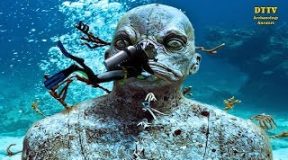Atlantis is the subject of a short but important article appearing in the Annual Report of the Board of Regents of The Smithsonian Institution for the year ending June 30th, 1915. The author, M. Pierre Termier, a member of the Academy of Sciences and Director of Service of the Geologic Chart of France, in 1912 delivered a lecture on the Atlantean hypothesis before the Institut Océanographique; it is the translated notes of this remarkable lecture that are published in the Smithsonian report.
“After a long period of disdainful indifference,” writes M. Termier, “observe how in the last few years science is returning to the study of Atlantis. How many naturalists, geologists, zoologists, or botanists are asking one another today whether Plato has not transmitted to us, with slight amplification, a page from the actual history of mankind. No affirmation is yet permissible; but it seems more and more evident that a vast region, continental or made up of great islands, has collapsed west of the Pillars of Hercules, otherwise called the Strait of Gibraltar, and that its collapse occurred in the not far distant past. In any event, the question of Atlantis is placed anew before men of science; and since I do not believe that it can ever be solved without the aid of oceanography, I have thought it natural to discuss it here, in this temple of maritime science, and to call to such a problem, long scorned but now being revived, the attention of oceanographers, as well as the attention of those who, though immersed in the tumult of cities, lend an ear to the distant murmur of the sea.”
In his lecture M. Termier presents geologic, geographic, and zoologic data in substantiation of the Atlantis theory. Figuratively draining the entire bed of the Atlantic Ocean, he considers the inequalities of its basin and cites locations on a line from the Azores to Iceland where dredging has brought lava to the surface from a depth of 3,000 meters. The volcanic nature of the islands now existing in the Atlantic Ocean corroborates Plato’s statement that the Atlantean continent was destroyed by volcanic cataclysms. M. Termier also advances the conclusions of a young French zoologist, M. Louis Germain, who admitted the existence of an Atlantic continent connected with the Iberian Peninsula and with Mauritania and prolonged toward the south so as to include some regions of desert climate. M. Termier concludes his lecture with a graphic picture of the engulfment of that continent.
The description of the Atlantean civilization given by Plato in the Critias may be summarized as follows. In the first ages the gods divided the earth among themselves, proportioning it according to their respective dignities. Each became the peculiar deity of his own allotment and established therein temples to himself, ordained a priestcraft, and instituted a system of sacrifice. To Poseidon was given the sea and the island continent of Atlantis. In the midst of the island was a mountain which was the dwelling place of three earth-born primitive human beings—Evenor; his wife, Leucipe; and their only daughter, Cleito. The maiden was very beautiful, and after the sudden death of her parents she was wooed by Poseidon, who begat by her five pairs of male children. Poseidon apportioned his continent among these ten, and Atlas, the eldest, he made overlord of the other nine. Poseidon further called the country Atlantis and the surrounding sea the Atlantic in honor of Atlas. Before the birth of his ten sons, Poseidon divided the continent and the coastwise sea into concentric zones of land and water, which were as perfect as though turned upon a lathe. Two zones of land and three of water surrounded the central island, which Poseidon caused to be irrigated with two springs of water—one warm and the other cold.
The descendants of Atlas continued as rulers of Atlantis, and with wise government and industry elevated the country to a position of surpassing dignity. The natural resources of Atlantis were apparently limitless. Precious metals were mined, wild animals domesticated, and perfumes distilled from its fragrant flowers. While enjoying the abundance natural to their semitropic location, the Atlanteans employed themselves also in the erection of palaces, temples, and docks. They bridged the zones of sea and later dug a deep canal to connect the outer ocean with the central island, where stood the palaces and temple of Poseidon, which excelled all other structures in magnificence. A network of bridges and canals was created by the Atlanteans to unite the various parts of their kingdom.
Plato then describes the white, black, and red stones which they quarried from beneath their continent and used in the construction of public buildings and docks. They circumscribed each of the land zones with a wall, the outer wall being covered with brass, the middle with tin, and the inner, which encompassed the citadel, with orichalch. The citadel, on the central island, contained the palaces, temples, and other public buildings. In its center, surrounded by a wall of gold, was a sanctuary dedicated to Cleito and Poseidon. Here the first ten princes of the island were born and here each year their descendants brought offerings. Poseidon’s own temple, its exterior entirely covered with silver and its pinnacles with gold, also stood within the citadel. The interior of the temple was of ivory, gold, silver, and orichalch, even to the pillars and floor. The temple contained a colossal statue of Poseidon standing in a chariot drawn by six winged horses, about him a hundred Nereids riding on dolphins. Arranged outside the building were golden statues of the first ten kings and their wives.
In the groves and gardens were hot and cold springs. There were numerous temples to various deities, places of exercise for men and for beasts, public baths, and a great race course for horses. At various vantage points on the zones were fortifications, and to the great harbor came vessels from every maritime nation. The zones were so thickly populated that the sound of human voices was ever in the air.
That part of Atlantis facing the sea was described as lofty and precipitous, but about the central city was a plain sheltered by mountains renowned for their size, number, and beauty. The plain yielded two crops each year, in the winter being watered by rains and in the summer by immense irrigation canals, which were also used for transportation. The plain was divided into sections, and in time of war each section supplied its quota of fighting men and chariots.
The ten governments differed from each other in details concerning military requirements. Each of the kings of Atlantis had complete control over his own kingdom, but their mutual relationships were governed by a code engraved by the first ten kings on a column of orichalch standing in the temple of Poseidon. At alternate intervals of five and six years a pilgrimage was made to this temple that equal honor might be conferred upon both the odd and the even numbers. Here, with appropriate sacrifice, each king renewed his oath of loyalty upon the sacred inscription. Here also the kings donned azure robes and sat in judgment. At daybreak they wrote their sentences upon a golden tablet and deposited them with their robes as memorials. The chief laws of the Atlantean kings were that they should not take up arms against each other and that they should come to the assistance of any of their number who was attacked. In matters of war and great moment the final decision was in the hands of the direct descendants of the family of Atlas. No king had the power of life and death over his kinsmen without the assent of a majority of the ten.

Plato concludes his description by declaring that it was this great empire which attacked the Hellenic states. This did not occur, however, until their power and glory had lured the Atlantean kings from the pathway of wisdom and virtue. Filled with false ambition, the rulers of Atlantis determined to conquer the entire world. Zeus, perceiving the wickedness of the Atlanteans, gathered the gods into his holy habitation and addressed them. Here Plato’s narrative comes to an abrupt end, for the Critias was never finished. In the Timœus is a further description of Atlantis, supposedly given to Solon by an Egyptian priest and which concludes as follows:
But afterwards there occurred violent earthquakes and floods; and in a single day and night of rain all your warlike men in a body sank into the earth, and the island of Atlantis in like manner disappeared, and was sunk beneath the sea. And that is the reason why the sea in those parts is impassable and impenetrable, because there is such a quantity of shallow mud in the way; and this was caused by the subsidence of the island.
In the introduction to his translation of the Timæus, Thomas Taylor quotes from a History of Ethiopia written by Marcellus, which contains the following reference to Atlantis: “For they relate that in their time there were seven islands in the Atlantic sea, sacred to Proserpine; and besides these, three others of an immense magnitude; one of which was sacred to Pluto, another to Ammon, and another, which is the middle of these, and is of a thousand stadia, to Neptune.” Crantor, commenting upon Plato, asserted that the Egyptian priests declared the story of Atlantis to be written upon pillars which were still preserved circa 300 B.C. (See Beginnings or Glimpses of Vanished Civilizations.) Ignatius Donnelly, who gave the subject of Atlantis profound study, believed that horses were first domesticated by the Atlanteans, for which reason they have always been considered peculiarly sacred to Poseidon. (See Atlantis.)
From a careful consideration of Plato’s description of Atlantis it is evident that the story should not be regarded as wholly historical but rather as both allegorical and historical. Origen, Porphyry, Proclus, Iamblichus, and Syrianus realized that the story concealed a profound philosophical mystery, but they disagreed as to the actual interpretation. Plato’s Atlantis symbolizes the threefold nature of both the universe and the human body. The ten kings of Atlantis are the tetractys, or numbers, which are born as five pairs of opposites. (Consult Theon of Smyrna for the Pythagorean doctrine of opposites.) The numbers 1 to 10 rule every creature, and the numbers, in turn, are under the control of the Monad, or 1—the Eldest among them.
With the trident scepter of Poseidon these kings held sway over the inhabitants of the seven small and three great islands comprising Atlantis. Philosophically, the ten islands symbolize the triune powers of the Superior Deity and the seven regents who bow before His eternal throne. If Atlantis be considered as the archetypal sphere, then its immersion signifies the descent of rational, organized consciousness into the illusionary, impermanent realm of irrational, mortal ignorance. Both the sinking of Atlantis and the Biblical story of the “fall of man” signify spiritual involution—a prerequisite to conscious evolution.
Either the initiated Plato used the Atlantis allegory to achieve two widely different ends or else the accounts preserved by the Egyptian priests were tampered with to perpetuate the secret doctrine. This does not mean to imply that Atlantis is purely mythological, but it overcomes the most serious obstacle to acceptance of the Atlantis theory, namely, the fantastic accounts of its origin, size, appearance, and date of destruction—9600 B.C. In the midst of the central island of Atlantis was a lofty mountain which cast a shadow five thousand stadia in extent and whose summit touched the sphere of œther. This is the axle mountain of the world, sacred among many races and symbolic of the human head, which rises out of the four elements of the body. This sacred mountain, upon whose summit stood the temple of the gods, gave rise to the stories of Olympus, Meru, and Asgard. The City of the Golden Gates—the capital of Atlantis—is the one now preserved among numerous religions as the City of the Gods or the Holy City. Here is the archetype of the New Jerusalem, with its streets paved with gold and its twelve gates shining with precious stones.
“The history of Atlantis,” writes Ignatius Donnelly, “is the key of the Greek mythology. There can be no question that these gods of Greece were human beings. The tendency to attach divine attributes to great earthly rulers is one deeply implanted in human nature.” (See Atlantis.)
The same author sustains his views by noting that the deities of the Greek pantheon were not looked upon as creators of the universe but rather as regents set over it by its more ancient original fabricators. The Garden of Eden from which humanity was driven by a flaming sword is perhaps an allusion to the earthly paradise supposedly located west of the Pillars of Hercules and destroyed by volcanic cataclysms. The Deluge legend may be traced also to the Atlantean inundation, during which a “world” was destroyed by water.
Was the religious, philosophic, and scientific knowledge possessed by the priestcrafts of antiquity secured from Atlantis, whose submergence obliterated every vestige of its part in the drama of world progress? Atlantean sun worship has been perpetuated in the ritualism and ceremonialism of both Christianity and pagandom. Both the cross and the serpent were Atlantean emblems of divine wisdom. The divine (Atlantean) progenitors of the Mayas and Quichés of Central America coexisted within the green and azure radiance of Gucumatz, the “plumed” serpent. The six sky-born sages came into manifestation as centers of light bound together or synthesized by the seventh—and chief—of their order, the “feathered” snake. (See the Popol Vuh.) The title of “winged” or “plumed” snake was applied to Quetzalcoatl, or Kukulcan, the Central American initiate. The center of the Atlantean Wisdom-Religion was presumably a great pyramidal temple standing on the brow of a plateau rising in the midst of the City of the Golden Gates. From here the Initiate-Priests of the Sacred Feather went forth, carrying the keys of Universal Wisdom to the uttermost parts of the earth.
The mythologies of many nations contain accounts of gods who “came out of the sea.” Certain shamans among the American Indians tell of holy men dressed in birds’ feathers and wampum who rose out of the blue waters and instructed them in the arts and crafts. Among the legends of the Chaldeans is that of Oannes, a partly amphibious creature who came out of the sea and taught the savage peoples along the shore to read and write, till the soil, cultivate herbs for healing, study the stars, establish rational forms of government, and become conversant with the sacred Mysteries. Among the Mayas, Quetzalcoatl, the Savior-God (whom some Christian scholars believe to have been St. Thomas), issued from the waters and, after instructing the people in the essentials of civilization, rode out to sea on a magic raft of serpents to escape the wrath of the fierce god of the Fiery Mirror, Tezcatlipoca.
May it not have been that these demigods of a fabulous age who, Esdras- like, came out of the sea were Atlantean priests? All that primitive man remembered of the Atlanteans was the glory of their golden ornaments, the transcendency of their wisdom, and the sanctity of their symbols—the cross and the serpent. That they came in ships was soon forgotten, for untutored minds considered even boats as supernatural. Wherever the Atlanteans proselyted they erected pyramids and temples patterned after the great sanctuary in the City of the Golden Gates. Such is the origin of the pyramids of Egypt, Mexico, and Central America. The mounds in Normandy and Britain, as well as those of the American Indians, are remnants of a similar culture. In the midst of the Atlantean program of world colonization and conversion, the cataclysms which sank Atlantis began. The Initiate-Priests of the Sacred Feather who promised to come back to their missionary settlements never returned; and after the lapse of centuries tradition preserved only a fantastic account of gods who came from a place where the sea now is.
H. P. Blavatsky thus sums up the causes which precipitated the Atlantean disaster: “Under the evil insinuations of their demon, Thevetat, the Atlantis-race became a nation of wicked magicians. In consequence of this, war was declared, the story of which would be too long to narrate; its substance may be found in the disfigured allegories of the race of Cain, the giants, and that of Noah and his righteous family. The conflict came to an end by the submersion of the Atlantis; which finds its imitation in the stories of the Babylonian and Mosaic flood: The giants and magicians ‘* * * and all flesh died * * * and every man.’ All except Xisuthrus and Noah, who are substantially identical with the great Father of the Thlinkithians in the Popol Vuh, or the sacred book of the Guatemaleans, which also tells of his escaping in a large boat, like the Hindu Noah—Vaiswasvata.” (See Isis Unveiled.)
From the Atlanteans the world has received not only the heritage of arts and crafts, philosophies, and sciences, ethics and religions, but also the heritage of hate, strife, and perversion. The Atlanteans instigated the first war; and it has been said that all subsequent wars were fought in a fruitless effort to justify the first one and right the wrong which it caused. Before Atlantis sank, its spiritually illumined Initiates, who realized that their land was doomed because it had departed from the Path of Light, withdrew from the ill-fated continent.
Carrying with them the sacred and secret doctrine, these Atlanteans established themselves in Egypt, where they became its first “divine” rulers. Nearly all the great cosmologic myths forming the foundation of the various sacred books of the world are based upon the Atlantean Mystery rituals.
Editor’s Note: Chapter from Manly P. Hall’s The Secret Teachings Of All Ages








6 Comments
Chris
(August 3, 2019 - 3:15 pm)Im all for this, but here’s my main problem – it’s always presented from an abrahamic perspective – “oh, this mythological being is based on noah. He escaped a flood, and so all these older myths are clearly telling the story of noah. It’s not just atlantean (i.e. – PAGAN), but it’s “mosaic.”
Um, no. Judaism/Hebrewism et al…do not appear on the historical record until around 5-600 b.c.
If the story of atlantis has any truth to its time in history, that places it right around 9 THOUSAND years before the “chosen ones.”
Noah is a MOCKERY of the older, original, PAGAN myths. It’s a copy. And a poor one at that.
We need to stop looking at our native myths through an abrahamic lens. Our ancestors didn’t. They believed and LIVED according to these mythologies. They created arts, sciences, philosophies, and cultures around them. They weren’t exercising some sort of pre-christian tradition THOUSANDS of years BEFORE jesus, as a sign towards him, as morons like the various church father/theologians like to claim. That’s an insult to our pagan ancestors, who got this information on their own – through ancestor veneration, animism, and ultimately, true PAGANISM.
El was nowhere near the scene of this. Do not give it credit for that which it had no place.
Bodhi Mantra
(August 3, 2019 - 6:50 pm)Well Hall was giving a lecture to a western society, I think you are mis-reading him trying to validate Biblical material with him simply relating this knowledge in a way his main audience could understand and relate too. Hall was well aware Abrahamic material was a plagiarization and fraud. I have the entire book here on pdf to DL if you would like to read it, it is one of the greatest esoteric works ever published. Real Christianity was Greek helio-Gnosticism so it had indeed been around far longer than the Abrahamic fraud that came to replace it. Otherwise I agree with the rest my friend and I cover most of this here at the website. Insightful comment, ty.
Chris
(August 3, 2019 - 7:27 pm)Yes, you are right. Context is key, and more than likely, Hall would’ve been writing or speaking to abrahamists, either by choice, or default. Speaking in this way allows him to convey the idea without having make it feel like a slight against them.
It’s definitely this point that has grown some wearisome for me in the world – we have literal abrahamists dumbing down our various mythologies, and then selling it back to us in the form of comics, movies, and books. And then having the gall to claim that these things aren’t inherently folkish, and are for the whole world. Lioe they are the guardians of the various mythologies of the world, and their own is the key to understanding them. It’s cultural appropriation of the highest order, and truly demeaning and offensive. And I’ve grown so tired of it.
In any case, thanks for point out the pdf to me. Ive been meaning to read it. Any idea if it is still available in print form?
Bodhi Mantra
(August 3, 2019 - 7:44 pm)Great comment I agree 100%. Yah I have a copy myself you can find it at pretty much any bookstore (new books) I think, when I bought mine they had 3 copies in the store I think and got it right off the shelf (didn’t have to order it). Though I imagine you can probably find cheap copies on the net used ones and what not on (((Amazon))) and perhaps goodread or something. There is a link at the bottom of this article if you want the pdf version. I look forward to reading more of your insightful comments on other articles/videos. Namaste my bro and heil the aesir! 🙂
Chris
(August 7, 2019 - 12:41 am)Many thanks, good sir!
Bodhi Mantra
(August 7, 2019 - 3:09 am)Same to you my friend, blessings